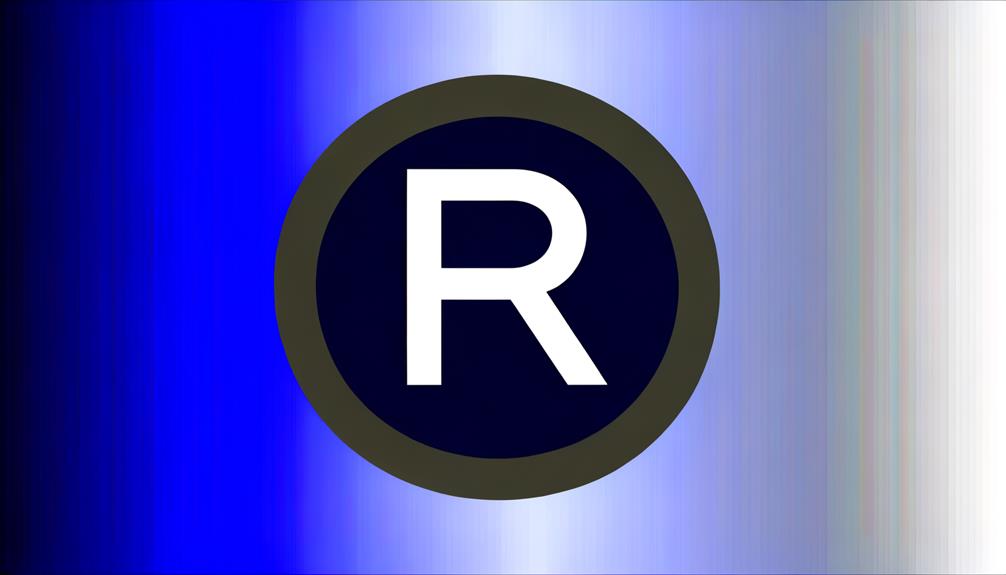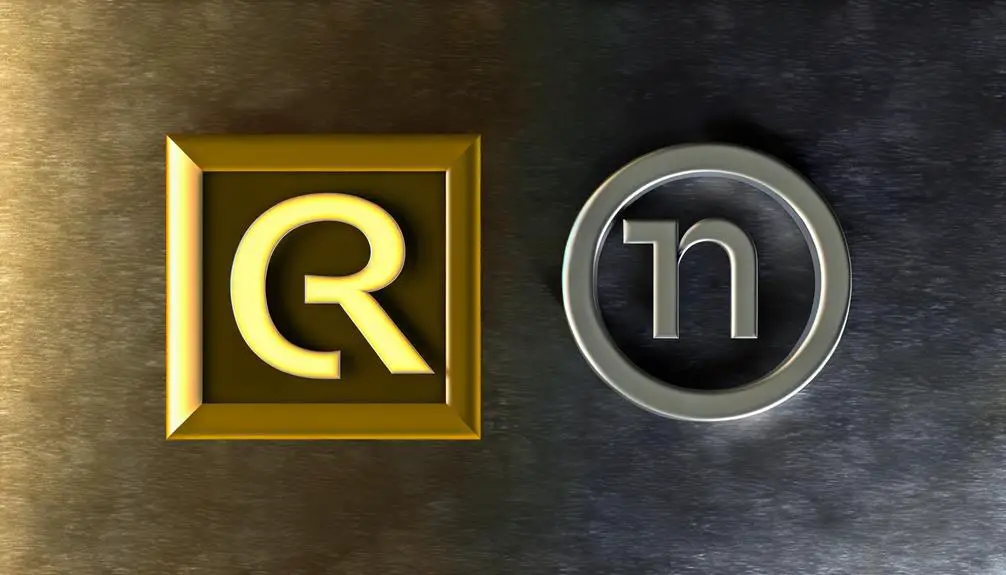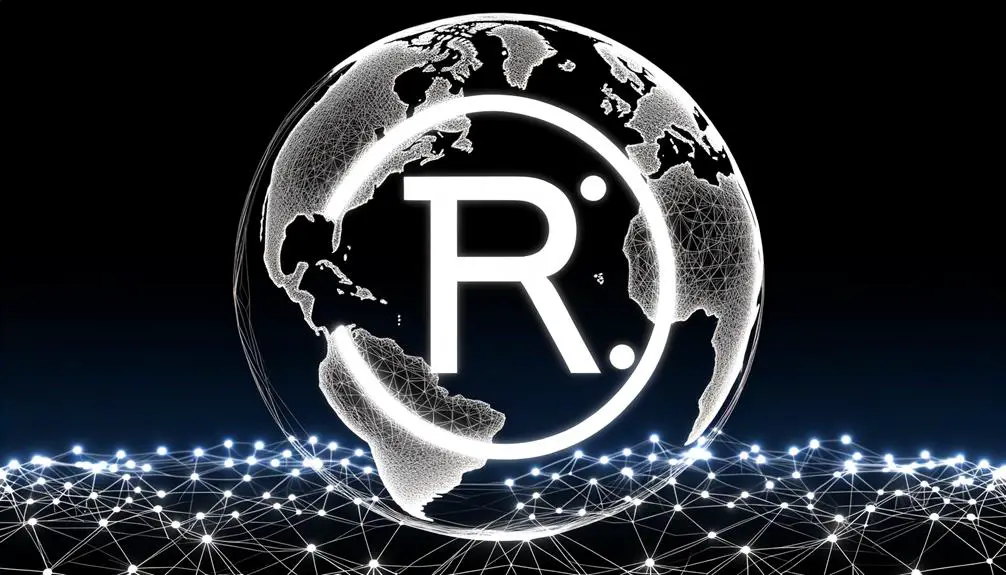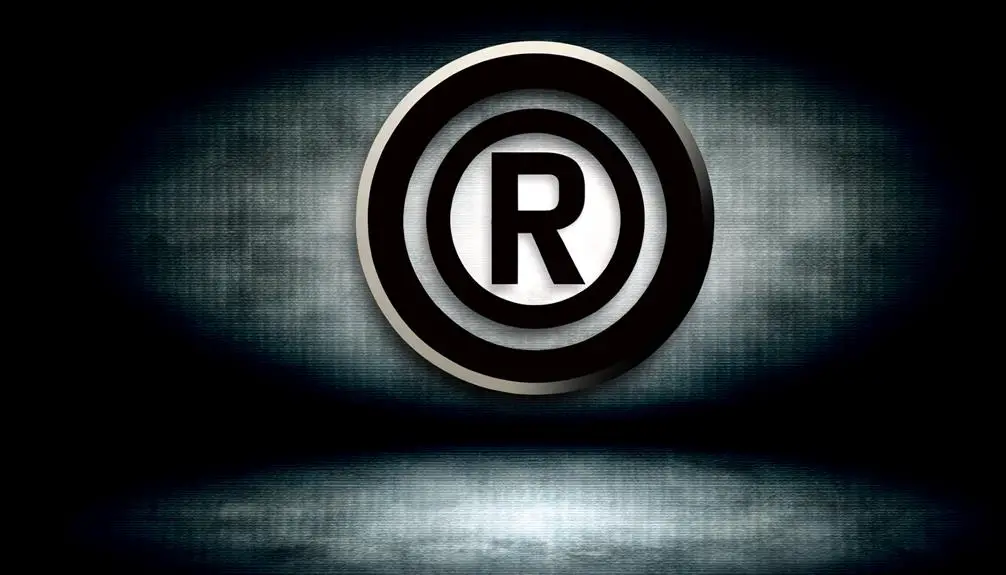What Does the Symbol R in a Circle Mean?
The symbol with an 'R' in a circle, ®, denotes a registered trademark. It signifies that the trademark is officially registered with the appropriate governmental authority, providing legal protection under trademark laws.
This symbol distinguishes registered trademarks from unregistered ones and enhances brand reputation and consumer trust. Unauthorized usage of the ® symbol can lead to legal consequences including monetary penalties.
Proper registration and adherence to legal requirements are essential for maintaining trademark rights. This symbol's importance in safeguarding brand identity and ensuring market position is evident in global business practices.
Learn more about its legal and strategic implications.

Key Takeaways
- The registered trademark symbol (®) indicates that a trademark is officially registered with the relevant trademark authority.
- It provides legal protection and exclusive rights to the trademark owner under trademark laws.
- Unauthorized use of the ® symbol can lead to legal consequences, including fines and injunctions.
- Proper registration and maintenance of the trademark are crucial for lawful use of the ® symbol.
- The ® symbol communicates brand authenticity and enhances consumer trust and brand reputation.
Definition and Meaning

The symbol with an 'R' in a circle, commonly known as the registered trademark symbol (®), signifies that a trademark has been officially registered with the relevant governmental authority. This registration provides formal recognition of the trademark's ownership, distinguishing it from unregistered trademarks.
The symbol communicates to the public that the mark is protected under trademark laws, which helps prevent unauthorized use. It not only identifies the source of goods or services but also enhances brand reputation and consumer trust.
Importantly, the ® symbol is exclusive to trademarks that have successfully undergone the registration process, validating the mark's distinctiveness and legality. Hence, its presence conveys a significant level of brand authenticity and legal validation.
Legal Implications
The legal implications of utilizing the symbol with an 'R' in a circle encompass vital facets such as trademark protection rights and the ramifications of infringement.
It is essential to understand that only trademarks officially registered with the appropriate governmental authority may legally employ this symbol, underscoring the significance of adhering to registration requirements.
Failure to comply with these legal stipulations can result in severe consequences, including litigation and financial penalties.
Trademark Protection Rights
Understanding the legal implications of the ® symbol is vital for ensuring proper trademark protection rights. The ® symbol indicates that a trademark is federally registered with the United States Patent and Trademark Office (USPTO), thereby granting the owner exclusive rights to its use in connection with the goods or services listed in the registration.
This exclusivity empowers the trademark owner to prevent unauthorized use, thereby safeguarding brand identity and market position. Additionally, federal registration provides a presumption of ownership and validity, which can be pivotal in legal disputes.
It is important to note that the ® symbol should only be used once the trademark registration is officially granted, as premature use can lead to penalties and weaken the enforceability of the mark.
Infringement Consequences Explained
Maintaining proper use of the ® symbol is not just about securing trademark protection rights but also about mitigating the significant legal consequences of trademark infringement. Unauthorized use or misuse of a registered trademark can lead to substantial legal repercussions, including injunctions, monetary damages, and even the destruction of infringing goods.
Courts may award damages based on actual losses, infringer's profits, or statutory damages, which can be substantial. Additionally, willful infringement can result in enhanced penalties and legal costs. Businesses may also suffer reputational harm and loss of consumer trust.
As a result, adhering to proper trademark usage is essential for avoiding costly litigation and safeguarding brand integrity. Compliance ensures both legal protection and business longevity.
Registration Legal Requirements
Finding one's way through the legal complexities of trademark registration requires a thorough understanding of jurisdiction-specific requirements and procedural mandates. The legal implications of registering a trademark vary significantly across different jurisdictions, necessitating careful compliance to avoid inadvertent pitfalls.
Key procedural mandates include:
- Application Submission: Properly completing and submitting the trademark application, including relevant classifications and descriptions.
- Examination Process: Undergoing a rigorous examination by trademark authorities to ensure the mark's distinctiveness and non-infringement.
- Renewal and Maintenance: Adhering to renewal timelines and maintenance requirements to keep the trademark in force.
Failure to adhere to these requirements can result in the refusal of registration or the loss of trademark rights, highlighting the importance of precision and diligence in the registration process.
Registration Process

The registration process for obtaining a trademark symbol, denoted by an 'R' encircled, involves several critical steps designed to protect and formalize intellectual property rights. Initially, one must conduct a thorough trademark search to make sure the chosen mark is not already in use or too similar to existing trademarks.
Following this, an application must be submitted to the relevant national or regional trademark office, detailing the mark and its intended use. This application undergoes a rigorous examination process, where it is assessed for compliance with legal requirements and potential conflicts.
If approved, the mark is published for opposition, giving third parties an opportunity to contest. Absent opposition, the mark proceeds to registration, granting legal protection and exclusive rights.
Benefits for Businesses
The use of the registered trademark symbol (®) confers significant advantages for businesses, primarily through enhanced legal protection of the brand. This legal safeguard deters unauthorized use and potential infringement, thereby preserving brand integrity.
Additionally, the symbol fosters market trust, signaling to consumers that the brand meets established standards and is legally recognized.
Brand Legal Protection
Securing brand legal protection through trademark registration offers businesses significant advantages in safeguarding their intellectual property and enhancing market competitiveness. By legally registering a brand's trademarks, companies can effectively deter unauthorized use and reduce the risk of brand dilution. This legal fortification provides several key benefits:
- Exclusive Rights: Trademark registration grants the owner the exclusive right to use the mark in commerce, preventing others from using a similar mark.
- Legal Recourse: Registered trademarks enable businesses to take legal action against infringers, ensuring swift and decisive measures to protect brand integrity.
- Asset Value: A registered trademark can be a valuable asset, enhancing the overall value of the business and providing leverage in business negotiations.
These benefits collectively fortify a brand's market position.
Market Trust Enhancement
Consistently, a registered trademark enhances consumer trust by signifying a brand's commitment to quality and authenticity. This symbol, often represented as an 'R' within a circle, acts as a powerful indicator that the product or service has met stringent legal standards and is legally protected against infringement.
Such assurance bolsters consumer confidence, encouraging repeat purchases and fostering customer loyalty. Additionally, the visible trademark differentiates a brand from competitors, establishing a unique identity in the marketplace. This differentiation not only attracts discerning customers but also enhances the perceived value of the brand.
Ultimately, the presence of a registered trademark serves as a proof of a company's dedication to maintaining high standards, thereby reinforcing market trust and driving business growth.
Differences From ™ Symbol

Unlike the Registered Trademark symbol (®), the ™ symbol signifies an unregistered trademark, indicating that the term or logo is being claimed as a trademark by the entity using it.
This distinction carries several legal and perceptual differences:
- Legal Protection: The ® symbol denotes a trademark registered with the relevant governmental authority, providing legal protection nationwide, whereas the ™ symbol offers limited common law rights.
- Market Perception: The ® symbol often commands higher trust and recognition in the marketplace compared to the ™ symbol.
- Usage Requirements: Utilizing the ® symbol without official registration is unlawful and can result in penalties; however, the ™ symbol can be freely used without formal registration.
Understanding these differences is essential for effective trademark management.
Common Misconceptions
A prevalent misconception is that the ® symbol and the ™ symbol offer the same level of legal protection. In reality, the ® symbol denotes a registered trademark, which has undergone a formal registration process with a national or regional trademark office, granting stronger legal rights.
Conversely, the ™ symbol indicates a claim to a trademark that has not been registered, providing some level of protection but not the robust legal enforceability of a registered trademark. This misunderstanding can lead businesses to erroneously believe they have complete protection when they do not.
Understanding the distinction between these symbols is essential for effective brand management and legal safeguarding.
Global Use

Understanding the global use of the ® symbol requires an examination of the varying trademark laws and registration processes across different jurisdictions. Trademark regulations differ significantly, influencing how and where the ® symbol can be legally used.
In the United States, for example, the symbol denotes a trademark registered with the U.S. Patent and Trademark Office. By contrast, the European Union offers a unified system through the European Union Intellectual Property Office (EUIPO), simplifying trademark protection across member states.
Key considerations include:
- Jurisdictional differences: Diverse legal frameworks necessitate tailored compliance strategies.
- Registration prerequisites: Each region has unique criteria for trademark registration.
- Enforcement mechanisms: Varying levels of legal recourse impact trademark protection globally.
These factors collectively shape the strategic use of the ® symbol worldwide.
Case Studies
Examining real-world examples reveals how companies strategically leverage the ® symbol to enhance brand protection and market positioning.
Apple Inc., for instance, uses the ® symbol extensively to safeguard its brand identity and deter counterfeit products. By registering trademarks, Apple guarantees legal recourse against infringement and maintains its market exclusivity.
Similarly, Coca-Cola employs the ® symbol to protect its globally recognized logo and brand name, reinforcing its market dominance and consumer trust.
Another case is Nike, which utilizes the ® symbol to secure its iconic 'Swoosh' logo, thus preventing unauthorized usage and preserving brand integrity.
These examples illustrate the critical role of the ® symbol in a thorough intellectual property strategy, enabling companies to safeguard their brand assets effectively.
Protecting Your Trademark

Building on these case studies, businesses must adopt proactive measures to protect their trademarks and secure their long-term viability in the competitive market.
Effective trademark protection involves several strategic actions:
- Registration: Confirm trademarks are registered with appropriate national and international trademark offices to establish legal ownership and rights.
- Monitoring: Regularly observe the market for any unauthorized use of the trademark to prevent dilution and infringement.
- Enforcement: Promptly uphold trademark rights through legal actions against infringers to maintain exclusivity and brand integrity.
These measures are essential to safeguard intellectual property and sustain brand equity in a dynamic business environment. Companies that implement these strategies can better navigate legal challenges and maintain their competitive edge.
Conclusion
The symbol with an 'R' in a circle, denoting a registered trademark, carries substantial legal weight and offers numerous benefits to businesses.
Importantly, USPTO data reveals that trademark registrations surged by 10% in 2022, underscoring its growing significance.
Differentiating it from the ™ symbol, understanding the registration process, and recognizing global variations are essential for effective trademark protection.
These elements collectively highlight the strategic value of securing a registered trademark in a competitive market.






